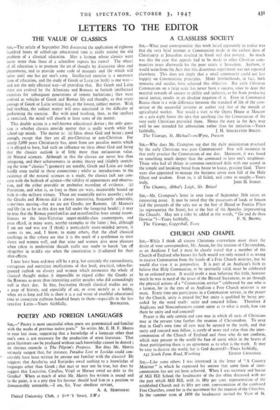SIR,—Like some others I was interested in the letter of
" A Country Minister " in which he expressed his sorrow that some form of inter- communion has not yet been achieved. When I was secretary and bursar of Mill Hill School the headmaster of the day often discussed with me the part which Mill Hill, with its fifty per cent. representation of the established Church and its fifty per cent. representation of the combined Free Churches, stood for in the movement for the reunion of the Churches. In the summer term of 1939 the headmaster invited the Vicar of St. Paul's Church, Mill Hill, with his class of confirmation candidates to par- take in a joint service of Communion with his, the headmaster's, class of candidates for admission to a Free Church, in the school chapel. The vicar was sympathetic. He referred the matter to the Bishop of Willesden, who in turn referred it to the Bishop of London. The answer was in the negative. The war supervened. The school's buildings were requisi- tioned by the Government as an emergency hospital. The school evacuated to St. Bees in Cumberland. There we shared the chapel of St. Bees School. In the summer term of 1940 there was a new headmaster of Mill Hill. I suggested to him that we should try to arrange for a joint Communion service of the two classes of boys prepared for their first Communion. The invitation was made to the local vicar, who conveyed it to the Bishop Suffragan of Barrow who confirmed the Anglican candi- dates at St. Bees. The Bishop of Barrow, who was very sympathetic, referred it to higher authority. The answer was in the negative.
In each case, the answer was, no doubt, strictly in accordance with the Order of the Church of England. What will greatly impress the world is visible unity, but it must be based on a spirit of brotherly love.—



































 Previous page
Previous page